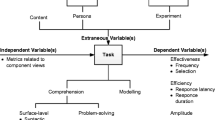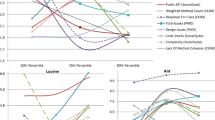Abstract
Substantial development time is devoted to software maintenance and testing. As development resources are usually finite, there is a risk that some components receive insufficient effort for thorough testing. Architectural complexity (e.g. tight coupling) can make effective testing particularly challenging. Software components with high architectural complexity are more likely be defect–prone. The aim of this study is to investigate the relationship between established architectural attributes and defect–proneness. We used the architectural attributes: abstractness, instability and distance to measure the architectural complexity of software components. We investigated the ability of these attributes to discriminate between defective and non-defective components on four open source systems. We visualised defect–proneness by plotting architectural complexity and defectiveness using Martin’s ‘Zones of Pain’. Our results show that architecture has an inconsistent impact on defect–proneness. Some architecturally complex components seem immune to defects in some projects. In other projects architecturally complex components significantly suffer from defects. Where architectural complexity does increase defect–proneness the impact is strong. We recommend practitioners monitor the architectural complexity of their software components over time by visualising potential defect–proneness using Martin’s Zones of Pain.
Access this chapter
Tax calculation will be finalised at checkout
Purchases are for personal use only
Similar content being viewed by others

References
Abreu, F.B.: The mood metrics set. In: proceedings of ECOOP, vol. 95, p. 267 (1995)
Ahmed, I., Gopinath, R., Brindescu, C., Groce, A., Jensen, C.: Can testedness be effectively measured? In: Proceedings of the 2016 24th ACM SIGSOFT International Symposium on Foundations of Software Engineering, pp. 547–558 (2016)
Almugrin, S., Albattah, W., Alaql, O., Alzahrani, M., Melton, A.: Instability and abstractness metrics based on responsibility. In: 2014 IEEE 38th Annual Computer Software and Applications Conference, pp. 364–373. IEEE (2014)
Almugrin, S., Albattah, W., Melton, A.: Using indirect coupling metrics to predict package maintainability and testability. J. Syst. Softw. 121, 298–310 (2016)
Bach, T., Andrzejak, A., Pannemans, R., Lo, D.: The impact of coverage on bug density in a large industrial software project. In: Empirical Software Engineering and Measurement (ESEM), pp. 307–313. IEEE (2017)
Bavota, G., Qusef, A., Oliveto, R., De Lucia, A., Binkley, D.: Are test smells really harmful? An empirical study. Empirical Softw. Eng. 20(4), 1052–1094 (2015)
Chidamber, S.R., Kemerer, C.F.: A metrics suite for object oriented design. IEEE Trans. Softw. Eng. 20(6), 476–493 (1994)
Elish, M.O., Al-Yafei, A.H., Al-Mulhem, M.: Empirical comparison of three metrics suites for fault prediction in packages of object-oriented systems: A case study of eclipse. Adv. Eng. Softw. 42(10), 852–859 (2011)
Gamma, E.: Design Patterns: Elements of Reusable Object-oriented Software. Pearson Education, India (1995)
Hall, T., Zhang, M., Bowes, D., Sun, Y.: Some code smells have a significant but small effect on faults. ACM Trans. Softw. Eng. Methodol. (TOSEM) 23(4), 1–39 (2014)
Izurieta, C., Bieman, J.M.: Testing consequences of grime buildup in object oriented design patterns. In: 2008 1st International Conference on Software Testing, Verification, and Validation, pp. 171–179 (2008)
Jaafar, F., Guéhéneuc, Y.-G., Hamel, S., Khomh, F., Zulkernine, M.: Evaluating the impact of design pattern and anti-pattern dependencies on changes and faults. Empirical Softw. Eng. 21(3), 896–931 (2015). https://doi.org/10.1007/s10664-015-9361-0
Khomh, F., Di Penta, M., Guéhéneuc, Y.G., Antoniol, G.: An exploratory study of the impact of antipatterns on class change-and fault-proneness. Empirical Softw. Eng. 17(3), 243–275 (2012)
Martin, R.C.: Agile Software Development: Principles, Patterns, and Practices. Prentice Hall, Upper Saddle River (2003)
Śliwerski, J., Zimmermann, T., Zeller, A.: When do changes induce fixes? In: Proceedings of the 2005 International Workshop on Mining Software Repositories, MSR 2005, pp. 1–5. ACM, New York (2005)
Acknowledgements
This work was partly funded by a grant from the UK’s Engineering and Physical Sciences Research Council under grant number: EP/S005730/1.
Author information
Authors and Affiliations
Corresponding authors
Editor information
Editors and Affiliations
Rights and permissions
Copyright information
© 2020 Springer Nature Switzerland AG
About this paper
Cite this paper
Petrić, J., Hall, T., Bowes, D. (2020). Zones of Pain: Visualising the Relationship Between Software Architecture and Defects. In: Shepperd, M., Brito e Abreu, F., Rodrigues da Silva, A., Pérez-Castillo, R. (eds) Quality of Information and Communications Technology. QUATIC 2020. Communications in Computer and Information Science, vol 1266. Springer, Cham. https://doi.org/10.1007/978-3-030-58793-2_11
Download citation
DOI: https://doi.org/10.1007/978-3-030-58793-2_11
Published:
Publisher Name: Springer, Cham
Print ISBN: 978-3-030-58792-5
Online ISBN: 978-3-030-58793-2
eBook Packages: Computer ScienceComputer Science (R0)



